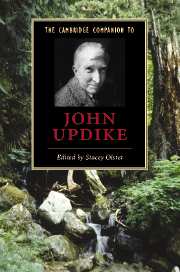Book contents
- Frontmatter
- Introduction: “A sort of helplessly 50’s guy”
- Part I Early influences and recurrent concerns
- Part II Controversy and difference
- Part III American chronicles
- 7 Updike, American history, and historical methodology
- 8 Updike, Hawthorne, and American literary history
- 9 Updike, film, and American popular culture
- 10 Updike, Rabbit, and the myth of American exceptionalism
- Conclusion: U(pdike) & P(ostmodernism)
- Select bibliography
- Index
8 - Updike, Hawthorne, and American literary history
from Part III - American chronicles
Published online by Cambridge University Press: 28 August 2006
- Frontmatter
- Introduction: “A sort of helplessly 50’s guy”
- Part I Early influences and recurrent concerns
- Part II Controversy and difference
- Part III American chronicles
- 7 Updike, American history, and historical methodology
- 8 Updike, Hawthorne, and American literary history
- 9 Updike, film, and American popular culture
- 10 Updike, Rabbit, and the myth of American exceptionalism
- Conclusion: U(pdike) & P(ostmodernism)
- Select bibliography
- Index
Summary
Shortly before fame first came to John Updike in 1968 - his impish face celebrated on the cover of Time as the author of that sensational wife-swapping novel, Couples - the 35-year-old was asked by the Paris Review if he considered himself part of an American literary tradition. Pressed further to comment on Nathaniel Hawthorne, Herman Melville, and Henry James, Updike responded, tellingly, “I love Melville and like James, but I tend to learn more from Europeans because I think they have strengths that reach back past Puritanism.”
By avoiding mention of Hawthorne, yet referring to that rigid religion associated as much with the author of The Scarlet Letter (1850) as with New England itself, Updike could not have been more in denial than if he had climbed upon Reverend Dimmesdale's midnight scaffold. That is ironic, considering all that we know, now, of Updike's longstanding fascination with the first American author to write a novel that Henry James proclaimed worthy of export, “as exquisite in quality as anything that had been received” from Europe. While the young Updike clearly felt it premature to allow himself to be linked to Hawthorne and an American literary tradition, an older Updike more at ease with the notion would simply say that “one would love even to aspire to be as good as Hawthorne.” He may have learned more from Europeans, but Updike did not hesitate to embrace Hawthorne later as an influence, even on Couples, which he described as being consciously set in “Hawthorne's territory,” a novel as much “about New England and the Puritan faith” as it was about marital infidelity in the early 1960s.
- Type
- Chapter
- Information
- The Cambridge Companion to John Updike , pp. 122 - 133Publisher: Cambridge University PressPrint publication year: 2006

